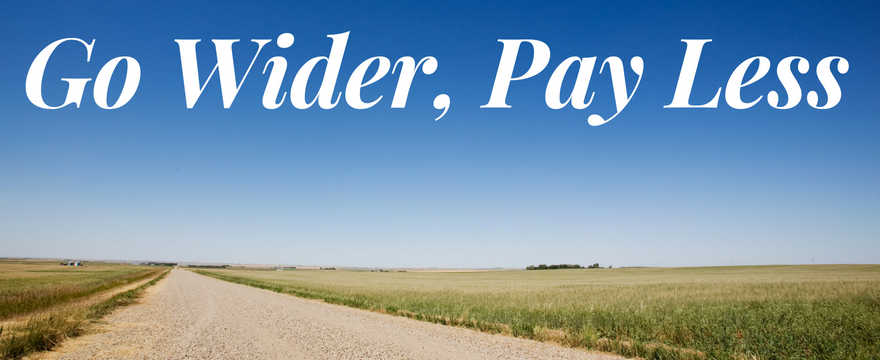
Clients come to me for Google Ads solutions, that’s what I do. Yes, I do the technical work of keywords, ads, and bids, yes I select all the right settings, and yes, I manage the accounts day to day. But really, when you break it all down, clients come to me for Google Ads solutions. They have a problem with their Google Ads, and I need to come up with a solution. Kind of like Vanilla Ice, if you got problem, yo I’ll solve it. That’s what I do, I solve problems.
One of the most common problems I get, both from movers, lawyers, and all my types of clients, is that in the client’s estimation, the cost per lead is too high. They like the leads they’re getting from Google Ads, the leads are helping them make money and grow their businesses, but the cost of those leads happens to be too high.
It’s at this point that many Google Ads managers would be worried, but I never am. At this point I’m calm, smiling, and happy that we know what the problem is. Once we know what the problem is, we can come up with the solution.
My Top Strategy For Getting The Cost Per Conversion Down
In the Google Ads world, we call the cost per lead the cost per conversion, so I’ll use those terms interchangeably. Let’s now break it down, and keep it simple. If the problem is that the cost per lead is too high, then we have to get the cost per lead lower.
So how do we get the cost per lead lower? Let’s assume all the basic stuff has already been knocked out… negative keywords, showing up on good search terms, setting up conversion tracking, good landing pages, etc. Let’s assume all of that stuff has been taken care of and is not the issue. If that’s the case, and we still need to get the cost per conversion lower, we only have two variables that we need to focus on. Cost per click and conversion rate.
If we can get our cost per click lower, the cost per conversion will go lower.
If we can get our conversion rate higher, the cost per conversion will go lower.
So those are the two variables that affect cost per conversion directly, and which direction they each need to go in to get cost per conversion lower.

In most of these “Jason, the cost per lead is too high” circumstances, getting the conversion rate higher is not going to happen. It’s not going to happen because a) Rothman PPC has made the Google Ads account just about as good as it can get. We’ve got the right negative keywords in there, we’re targeting the right keywords, we’ve got great ad copy, and we’re doing our job on the Google Ads side of things, in terms of getting in front of people searching for exactly what the client offers. And b) the client is not going to be able to improve things on their side. The landing pages or website are solid already, and the intake staff isn’t able to be improved. So the conversion rate variable in the equation is not going to be able to be changed.
So that leaves us with the cost per click. And the good news for all you Google Ads advertisers, is that the cost per click is very changeable. When you run your bids under manual bidding, the cost per click is under your control. You can keep going higher and higher until your average position is 1.0. Or you can keep going lower and lower until you’re unable to show up high enough or enough in general to get clicked on at all. Anywhere between those two ends of the spectrum is an available option.
Go Wider, Pay Less
Here is where the go wider, pay less strategy comes into play.
Remember, the problem is that the cost per lead is too high and we have to get that cost per conversion metric lower. The cost per conversion metric is lowered by increasing the conversion rate or decreasing the cost per click. We’ve determined that in most cases increasing the conversion rate is not going to be doable. That leaves us with lowering the cost per click as our only option.
But, assuming all things like quality score being equal, when we lower the cost per click, our positions, click volume, and lead volume all go down. This is fine if the client is happy with getting less leads but most clients are not. Clients want their cake and they want to eat it too. They want a lower cost per lead, but they want the same number of leads overall. They don’t want less lead volume.
How do you get a lower cost per conversion without hurting the overall number of conversions?
The answer is my go wider, pay less strategy. It works as follows.
More Auctions
Google Ads is a modified auction advertising system. And my primary strategy for getting a lower cost per lead without hurting my overall lead volume, is to show up on more auctions.
The more auctions you show up on and have a potential to get quality traffic from, the lower you can set your max cost per click bids and get away with it.
If an injury lawyer running ads in Los Angeles county told me he wanted a lower cost per conversion and our conversion rate was not going to be improved, then we would have to lower our bids, and if we were already fully optimized to get the most leads possible for the budget, then these lower bids would cause us to get less leads. The cost per conversion would go down with the lower bids, but so would the overall amount of conversions.
But if the injury lawyer shows up on more auctions, that gives us a chance to lower our cost per click, but not give up any conversion volume. The lawyer could:
A) Add additional hours to his advertising day and take calls after 5pm.
B) He could start running ads on weekends.
C) And to have the most impact, and generally what the go wider, pay less strategy refers to, he could expand the locations his ads show up in to Los Angeles and Orange County, to Los Angeles and all of southern California, or even to Los Angeles and the rest of the entire state of California.
Expanding the geography of where your ads can show up on your relevant keyword searches can drastically increase the amount of auctions you show up in and allow you to get away with a lower cost per click without lowering the overall amount of conversions you can get for the same budget.
We could bid less, show up in a lower position, get a lower clickthrough rate, and get a lower cost per conversion. But since we’re showing up in more auctions, the overall number of conversions can stay the same, even though we’re now paying less for them.
By lowering the cost per click, we can get a client a lower cost per conversion anytime, but generally the volume of conversions will go down as well. But if at the same time, we go wider with our location targeting, we can get a lower cost per conversion but we can still maintain the number of conversions we get, and therein lies the beauty of the go wider, pay less strategy.
This strategy won’t work for companies that are already targeting as large a location as possible, but that’s not the case with most clients I see. Most clients can still go larger with their location targeting. For example, I run ads for a large west coast injury law firm. They’re targeting the major city in their state, but they do service clients state-wide. They want to get their cost per case lower, but don’t want to get a lower case volume each month. So this week we had the “go wider” talk. I said “fellas, what are we doing here? You service clients state-wide but you’re limiting your ad campaign to just this major city. If we go wider and target the entire state, we can get away with a lower cost per click and still get the same number of clicks and cases since we’re going to be showing up on more auctions.” They instantly got it and are onboard, and now they’re going to see their cost per case get much more profitable, while not having to give up on the number of cases they get each month from Google Ads.
And that’s an example of how the go wider, pay less strategy works in real life.
If the cost per conversion needs to come down, and the account is already optimized and the conversion rate isn’t going to improve, your only option is to lower bids.
And if you want to lower bids without lowering conversion volume, then use the go wider, pay less strategy.
This strategy allows you to show up on more auctions, lower your cost per conversion, but still get the same number of conversions overall.